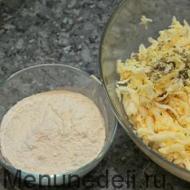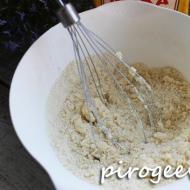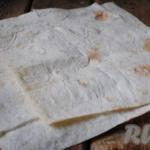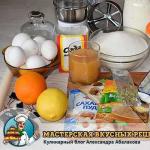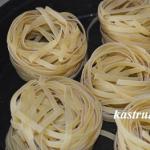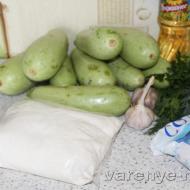
How to store cereals, pasta and flour. Where and in what is it better to store cereals? Where is the best place to store cereals?
In the diet of most of our compatriots, it is cereals that occupy a special place. Moreover, if we take into account the fact that their cost level is far from minimal, we should approach the process of storing cereals taking into account as many features as possible.

Basic rules
To properly store cereals at home to prevent moths, our ideas and recommendations will help you. According to many experts, the most favorable option is to store cereals in the bags (mainly paper or plastic) in which they were previously sold. The only drawback is their poor quality. But replacement is necessary only in extreme cases. Semolina is perfectly stored in plastic bottles or tin cans. Containers for buckwheat are containers.
Before storing the product, it is necessary to carefully inspect and sort it out. A common and not very pleasant phenomenon may be the presence of many small insects in the cereal. If the grains are not sorted and subsequently dried at medium temperature in the oven, you may encounter the proliferation of various spiders and their damage to other food products. If this was found in rice, the package of cereal should be placed in the freezer for a day. This will simultaneously help you defeat the spiders and fully preserve all the beneficial substances.


Everyone who at least once tried to make significant reserves of cereals was faced with the fact that small insects began to crawl out of them over time. You can cope with this problem using traditional folk remedies. For example, spread dried calendula at the bottom of the shelf on which the containers will stand. An alternative option could be garlic cloves placed in the corners of the appropriate place.
It is necessary to implement such a recommendation only on the condition that all cereals are stored in hermetically sealed containers, which minimizes the risk of their impregnation with foreign odors. Another general rule for storing cereals is to avoid the presence of strong-smelling substances (household chemicals, spices) nearby.

Selecting a location
At the present stage of development of room design, including kitchens, there are many options for storing cereals. Some people purchase special stands for this (depending on individual preferences and skills, they can be made independently), others use specially designed shelves for this, which can be considered as an original option for complementing the interior.
In any case, you need to remember that there should be a problem-free approach to the place where the containers with cereals are located; the housewife should be able to get to it without any discomfort. When storing cereals, you need to take into account the need to avoid direct sunlight, as well as sharp fluctuations in humidity levels and room temperature.

Temperature and humidity
Almost every person has encountered the phenomenon of rancid cereal at least once in their life. One of the most common factors that provoke its occurrence is precisely too high humidity. To preserve such products in normal condition, it is necessary that it does not exceed 65–70%.
Sometimes, under the influence of a number of external factors, the level of humidity can fluctuate, which affects the cereals accordingly. Therefore, it is necessary to empty them out at least once a month and carefully inspect them. If there is an unpleasant taste or odor, you must immediately discard the product and rinse the container thoroughly using special disinfectants.

As for the temperature regime, its optimal indicators should vary from +15 to +20 degrees. It must be remembered that cereals are capable of maintaining the temperature at which they were before for a long period. Therefore, if they have been in the sun for a long period or, conversely, in a room with a relatively low temperature, it is worth leaving the cereal in the room at room temperature and after that ensure proper storage.

How to choose a container?
Depending on the container in which the cereal is stored, its taste and shelf life depend. The most common materials used to make tableware include the following:
- glass;
- ceramics;
- linen or cotton fabric;
- tree;
- food plastic.



The need to preserve the product in the container in which it was purchased has already been noted. However, the use of ordinary plastic bags, especially if they are not tightly closed, is not advisable. There is a risk that the cereal will mate, which will negatively affect its taste. Many people prefer to store products in special glass containers, since in this case foreign odors and moisture do not penetrate. The main thing is that you can prevent the occurrence of pests that cause significant harm to food.
Some companies strive to produce such containers in different volumes and taking into account an original design approach, which makes it possible to implement the most daring and non-standard approaches to solving the problem of decorating a room in the kitchen. The negative point is the significant cost of such containers, so ordinary glass jars can be a replacement option. Initially, they must be thoroughly washed to get rid of foreign odors and dried. Another negative point may be increased fragility, as well as heavy weight. Handle such a container with extreme care to avoid cracks and glass particles getting into the food.

Plastic containers for storing cereals can be a kind of prototype. When choosing them, it is important to pay attention to the fact that they are made of a material that can be used for storing food. Most of them are equipped with a special dispenser, which makes it possible to make the process of pouring cereals more acceptable and faster. Thanks to their light weight, kitchen cabinets can accommodate many jars without the risk of overloading the cabinet.
Our mothers and grandmothers used iron containers to store cereals. Despite the fact that at first glance they seem quite reliable, the process of using them must be extremely careful. For example, you need to remember that they can rust. If the relevant elements enter the product, it may be considered completely unfit for consumption. A controversial option for high-quality storage of cereals are containers made from various types of wood. It seems that they are completely environmentally friendly and easy to use, but it is wood that actively absorbs foreign odors, which can cause irreparable harm to the product.
It is believed that containers for storing cereals made of ceramics help maintain all the necessary qualities for a long period. This is true, but the material itself is very heavy and fragile, which creates additional problems in its use. For many centuries, storage took place in fabric bags made from flax; it is advisable to initially wash them in salt and then iron them, which will help protect them from insects. This option is especially favorable for flour, millet and oats. A significant drawback can be considered instability to moisture.

Best before date
Contrary to the popular belief that all cereals have the same shelf life and storage conditions, in reality the situation is completely different. Of course, it is necessary to remember that everything depends on the endurance of the technological processes, as well as on the type of product. If we talk about the most common options, in this case the following terms are observed:
- wheat groats, processed in different ways, can be stored for no more than 16 months;
- barley porridge has a similar shelf life;
- rice - the maximum shelf life of nutrients and taste is one and a half years;
- oat flakes are usable for no more than 4 months from the date of their preparation; if we are talking about muesli (depending on how well the dried fruits are prepared), the period under consideration can be reduced several times;
- peas that have undergone the grinding process and rice that have been parboiled are used for 2.5 years.

Important! Every decent manufacturer must indicate the date of manufacture, duration of storage and conditions under which the product can retain its positive qualities. Deviation from these standards may indicate a decrease in shelf life, but in no case does it increase it.
Danger of improper storage
If you store food without taking into account the level of humidity, you can note a significant risk of the occurrence and rapid development of mold. In addition to the fact that it destroys products, giving them a not very pleasant taste and smell, active production of toxins occurs. Eating grains contaminated with mold can cause severe poisoning and can sometimes be life-threatening. Previously, attention was drawn to the high risk of insects infesting this product category.
In addition to the not very aesthetically attractive appearance of the products, they also provoke their poisoning and almost complete unsuitability for human consumption due to the high content of waste products.


Most cereals, despite the fact that their expiration date has long expired, do not change their appearance. But such products no longer contain the required amount of vitamins and microelements, and their taste also leaves much to be desired. Anyone who seeks to purchase products for future use must make appropriate notes on all containers, which will display the date of storage. Then organizing a normal nutrition process will become much easier.
In order to avoid expired products in the kitchen, it is necessary to conduct an audit of the kitchen at least once every six months, examining all expiration dates. By the way, if cereals are stored next to seasonings that have a strong odor, you must be aware of the increasing risk of food allergies.
Among many housewives, there is an opinion that it is best to store cereals in the refrigerator, as this will help save them from insects and the loss of nutrients. In fact, this does not correspond to reality, and excessive hypothermia, just like drying out a product, can lead to faster spoilage and loss of a significant part of the nutrients. If you purchase cereal by weight, and not in a bag sealed at the factory, you need to smell it well and pass it through your fingers.
Under no circumstances should there be any foreign odors, lumps or, so to speak, the feeling of dirty hands. Otherwise, you need to give up the idea of purchasing such low-quality products.

When examining cereals sold already packaged, you need to pay attention to whether there are any foreign inclusions (a number of unscrupulous manufacturers can sell a surrogate) and whether the packaging is intact. Despite the fact that on the Internet you can find a whole range of measures to ensure the rehabilitation of cereals after damage by insects, it is best not to take risks.
It must be remembered that even minor particles of vital activity can lead to negative consequences in the form of health problems.
To learn how to store cereals to prevent bugs from getting in, see the following video.
Flour and various types of cereals are included in the diet of almost every person. Cereals contain fiber and other beneficial substances that we need to replenish energy and protect against the influence of negative factors. And with the help of flour, every housewife can pamper her family with delicious and sweet pastries.
But for food to be truly healthy and tasty, it is important to prepare it from quality ingredients. Therefore, today we’ll talk about how to properly store cereals and flour at home so that they remain dry and do not get bugs in them.
Storing cereals and flour at home
Bulk products and flour have a long shelf life, so they are popular with many housewives. But if stored improperly, they lose their taste, become damp, or become a habitat for bugs and other pests.
- Kitchen cabinets. It is better to store cereals in the lower, away from heat sources (radiators or stoves), since under the influence of high temperatures they oxidize and spoil faster.
- A storage room or any other dry room. Cereals and flour do not like dampness.
- Open shelves- provided that the room itself is well ventilated and the cereals are in a closed container.
Containers for storing flour and cereals
Many housewives, after purchasing bulk products in a store, do not pour them into special containers, but leave them in their original packaging. This significantly reduces the storage time due to the lack of tightness.
After some time, paper or plastic packaging becomes unusable, cereals become damp, crumble, or become infested with harmful insects. For convenience and safety of products, it is recommended to use special containers:
- ceramic containers;
- plastic cans;
- glass containers;
- metal containers or stainless steel.
Hardware stores sell containers for every taste, color and budget. Many people choose storage containers based primarily on aesthetic preferences, taking into account the design of the kitchen. However, in order for bulk products to retain their taste and benefits for a long time, in addition to appearance, it is important to take into account other criteria.

Ceramic containers
Ceramic containers are considered the best containers for storing cereals. They are airtight, practical, and pleasing to the eye with an attractive design. This container is suitable if you prefer to store food on open shelves.
Ceramic jars do not allow sunlight to pass through, making them ideal for open storage. And their beautiful design gives the kitchen a special touch.
Plastic containers
Plastic containers are lightweight, practical and convenient. When using them, the load on the cabinet will be minimal. To optimize shelf space, choose a square or rectangular container.
When choosing a plastic container, pay attention to the quality of the material. Low-quality plastic has an unpleasant foreign odor, which will certainly affect the taste of the products. 
Metal cans
Metal cans are beautiful and durable, but have one significant drawback - over time, they develop rust stains. Similar stainless steel products do not have this drawback, but are also more expensive than other containers.
Glass jars
Glass containers are convenient and beautiful, have a variety of designs, and you can clearly see in them what cereals are stored and in what condition they are. Transparent glass jars are airtight and easy to clean.
The only drawback is that they break easily. Bulk products in glass containers are stored in a dark place without access to direct sunlight.
How long can cereals be stored?

If you buy cereals in large quantities, remember the shelf life:
- split and whole peas - 2 years;
- pasta - 2 years;
- buckwheat - 20 months;
- rice - 18 months;
- semolina - 10 months;
- millet - 9 months;
- oatmeal - 6-8 months;
- barley, wheat and other types of cereals - no more than 9-12 months.
The dangers of improper storage of bulk products
One of the most important problems that housewives face when storing bulk products is the appearance of mold due to high humidity or dampness in the apartment. You should not eat foods affected by mold, since its proliferation produces toxins that will cause irreparable harm to the body.
Another problem is pests in bulk products. The most common of them is the Suriname mucoed. This brown insect most often appears under improper storage conditions in flour, different types of cereals, and dried fruits.
Unlike microorganisms, beetles do not poison grains, but contaminate them. But if the content of insects in the cereal is high, their waste products will lead to intoxication or digestive problems.

Products that have expired may look completely normal in appearance, but their taste and beneficial properties have already been lost. If you prefer to shop ahead, use items you bought a long time ago first. And to keep track of how much time is left before the expiration date, hang stickers on the containers with the date the contents were added.
Once a month, conduct an audit of the kitchen, during which you check the contents of the cabinets and, if necessary, throw away anything that is damaged.
Many housewives wonder whether it is possible to store flour in. Flaxseed, almond or corn - yes, but experts advise first placing it in an airtight container. But it is better to store wheat flour in warm, dry conditions - pantries, cabinets.
To properly store flour, it is better to use:
- special plastic buckets;
- containers with hermetically sealed lids;
- glass jars with screw caps;
- metal cans with a seal on the lid to create a tight seal.
It is better not to use paper and cellophane bags, as well as rag bags for storing flour. They are where pests most often live.
To prevent harmful insects from infesting bulk products, use these popular tips:
- After purchase, heat the cereal in a frying pan or keep it in the freezer for a day directly in the packaging from the manufacturer.
- Place cloves of garlic, bay leaves, lemon peels, pieces of foil or ordinary tablespoons in a container with bulk products.
- To protect rice from a musty smell, place a pod of red hot pepper in a container with it.
- For winter, transfer bulk products to the balcony for storage. Low temperatures will not only protect them from bugs, but will also significantly extend their shelf life.
Conclusion
Compliance with all the rules for storing cereals and flour will help preserve supplies from spoilage and maintain cleanliness and order in the kitchen. But if mold or barn pests do appear, immediately throw away these products. You should not save on your health and the health of your loved ones.
Cereals are a long-term storage product. However, if the appropriate conditions are not met, it can become moldy, suffocate or absorb foreign odors, and sometimes pests infest it.
Therefore, when stocking up, you should create a cheat sheet: how to store cereals .
Suitable containers
 Even our grandmothers, trying to properly store cereals at home, packaged them in three-liter jars. Cereals were perfectly stored in glass jars placed on the shelves of kitchen cabinets, avoiding proximity to moisture and substances with specific aromas. And most importantly, there were no bugs in them.
Even our grandmothers, trying to properly store cereals at home, packaged them in three-liter jars. Cereals were perfectly stored in glass jars placed on the shelves of kitchen cabinets, avoiding proximity to moisture and substances with specific aromas. And most importantly, there were no bugs in them.
Modern housewives are still inclined to believe that it is better to store in special containers, especially now their choice is quite wide:
| Capacities | Evaluation criteria | |
|---|---|---|
| Positive | Negative | |
| Ceramic | Stylish, reliable, considered the best option for storage. For cereals, it is better to choose lids with silicone gaskets. | Not noted. |
| Made from glass | A great way, there is a modern design at an affordable price. No foreign odors will get in. Transparent containers make it possible to clearly see what is stored there, and they are always easy to wash. | Sometimes they break, unbreakable cans are more expensive. It is not recommended to use transparent glass, otherwise it should be stored in dark places. |
| Metal | High quality, presentable. | Over time they rust and can oxidize. Stainless steel cans are respectable in price. |
| Wooden | Gives coziness to the interior. Eco-friendly material. | Not the best option, as they absorb odors and moisture, are not airtight, and are difficult to clean. |
| Plastic | A convenient option, very light, compact: you can stack one on top of the other and place them in columns on a shelf without much load, they are attractive in appearance. | They don't always close hermetically. Plastic may have an odor. Scientists do not recommend using plastic products for a long time. |
Tip: some housewives prefer to store bulk products in a container, while others prefer to store them in a regular plastic bottle. It is necessary that any container is closed tightly, clean, and before use it is doused with boiling water and dried. A good option for storing in the kitchen are canvas bags that allow the cereals to breathe. It is guaranteed that pests will not infest the fabric by soaking the fabric in a saline solution (4 tablespoons of salt: 1 liter of water) and steaming it with an iron. Sometimes, to ensure safe preservation, bags of cereal are also placed in containers and covered. To prevent the cereal from suffocating, instead of a plastic or other lid, you can cover the container with canvas (linen) cloth, securing it to the neck with an elastic band.
The benefits of cold
 It is recommended to store cereals at a temperature no higher than 10 degrees. True, this cannot be achieved in the kitchen. A favorable place there is a kitchen cabinet: on the bottom shelf, away from electrical appliances and the stove, you can store it at a temperature of no more than 20°C and 70% humidity. At the same time, cereals such as semolina, oatmeal, pearl barley and millet require more coolness, as they are prone to rancidity. Special cool, dark closets are good for this. A temperature of about +5 degrees will ideally correspond to the conditions for cereals. The question arises, is it possible to store cereals in the refrigerator? Indeed, you can store cereals on a refrigerator shelf at this temperature in a hermetically sealed container if there is room for them and other options are unacceptable. For example, when you store them in the country and you are afraid that rodents may damage them in your absence. You should use a refrigerator if you want to freeze grains in the freezer. But it is not recommended to store it in basements and cellars, where it is damp and there is no ventilation.
It is recommended to store cereals at a temperature no higher than 10 degrees. True, this cannot be achieved in the kitchen. A favorable place there is a kitchen cabinet: on the bottom shelf, away from electrical appliances and the stove, you can store it at a temperature of no more than 20°C and 70% humidity. At the same time, cereals such as semolina, oatmeal, pearl barley and millet require more coolness, as they are prone to rancidity. Special cool, dark closets are good for this. A temperature of about +5 degrees will ideally correspond to the conditions for cereals. The question arises, is it possible to store cereals in the refrigerator? Indeed, you can store cereals on a refrigerator shelf at this temperature in a hermetically sealed container if there is room for them and other options are unacceptable. For example, when you store them in the country and you are afraid that rodents may damage them in your absence. You should use a refrigerator if you want to freeze grains in the freezer. But it is not recommended to store it in basements and cellars, where it is damp and there is no ventilation.
Ways to Prevent Insect Infestations
After purchasing cereal in a store, if no insects are found during the initial inspection, you can certainly get rid of invisible larvae and doubts about their presence. To do this, you can choose the optimal method, after which the bugs will definitely not start:
- Freeze on the freezer shelf for 4 days. You can also take advantage of low winter temperatures on a balcony or loggia, terrace or porch in private homes with short-term freezing rather than storage.
- Heat in the oven. There are differing opinions regarding this option. Some believe that it is convenient and does not harm cereals, others believe that it destroys the vitamins and proteins contained there.
- Cereals can be processed using oven microwaves. You need to keep it for 5 minutes so that the valuable properties of the products are not lost.
- Before storing, cereals should be sifted through a wide sieve, freeing them from debris and other foreign objects.
Shelf life
 To prevent cereals from spoiling, you need to consider how long they are stored. Different cereals differ in terms of timing:
To prevent cereals from spoiling, you need to consider how long they are stored. Different cereals differ in terms of timing:
- Up to 2 years: buckwheat and peas.
- Up to a year or more - corn grits and rice, semolina - in the refrigerator.
- Up to 12 months – regular pasta (with no more than 5 additives).
- Up to 9 – all cereals, except oatmeal and millet.
- Up to 5 - millet and oat flakes, and with additives - the period is even shorter.
Kitchen cabinets where cereals are planned to be stored should be wiped with a liquid to which vinegar has been added. You can place bay leaves or napkins soaked in lavender oil nearby, which will quickly lose their scent. If bugs brought along with cereals have already infested, then the shelves and corners are washed with hot water, with the addition of laundry soap. After this, spray insecticides and, keeping the cabinets closed, then ventilate them thoroughly.
Folk wisdom and experience have accumulated many recipes that help preserved cereals not to lose their beneficial qualities. So:
- hot pepper pods or garlic, unpeeled slices, placed in jars with rice will save it from mustiness and pests;
- with cereals, at the bottom of the jars you can put salt, poured into gauze bags, which eliminates extraneous aromas, excess moisture, or bay leaf, cloves, as well as chestnut or lemon zest;
- On top of the poured cereal, before closing the lid, place a mint chewing gum pad or dried mint leaves, whose smell repels cereal pests.
- inside the container with cereal you can put rolled up foil, a stainless steel plate or a spoon;
- dried citrus peels prevent the appearance of ants;
- matchboxes with sulfur applied to the sides are placed on the edges of shelves or on top of cereals so that the smell of sulfur repels insects.
Porridge is an excellent source of carbohydrates, and therefore energy for the human body. Every housewife must have several types of cereal so that at any time she can prepare tasty and healthy porridge for a side dish or just like that.
Of course, the days of former shortages have already passed. Those times when our grandmothers had three-liter jars in their closets filled to the brim with scarce buckwheat and less scarce domestic rice. Nowadays, you can buy any type of cereal at the grocery store. But even with frequent purchases of small quantities of cereal, you need to ensure its proper storage, and then the cereal will not lose its benefits.
Having bought cereals, do not store them in the plastic or paper bags in which you bought them, because the bag may tear, the cereal will scatter on the shelf or, in the worst case, on the floor, and then you will have to waste your time on cleaning. And it’s possible that debris will get into the cereal, and you’ll have to sort it out or throw it away altogether.

Also, cereal in a plastic bag can “suffocate”, since its storage requires a special perforated bag, and not all manufacturers comply with this condition. What often happens is that cereals are purchased in bulk and then packaged in ordinary plastic bags. And another important thing is that moisture can penetrate into perforated plastic and paper bags, as a result of which the cereal can become damp. Pests can also enter, and as a result, the cereal will be spoiled.
Therefore, immediately upon bringing the purchased cereals home, you need to pour them into a dry, clean glass or metal container. If the cereal requires it, you need to sort it out immediately. After all, if you do this, the cooking process will take much less time. You can entrust this painstaking work to children, then the cereal will be ready for use, and the children will be accustomed to work.

From time to time you need to open cans of cereal and check them for the presence of pests in the cereal. Do not eat already spoiled cereals. Pests can leave their waste products in cereals, which spoil the taste and smell of the finished dish. And if there is a high concentration of insect excrement in cereals, then you can even get poisoned.
What pests can you encounter in the kitchen and in cereals? Granary weevils, Surinamese flour beetles, bread borers and other pests can happily settle here. For humans, in principle, they are not dangerous, but they are unpleasant. These are bugs that can appear in your cereal for several reasons. The main reason is non-compliance with the rules for storing cereals. You can store cereals such as buckwheat, rice, semolina, and flour at home for six months, because they contain a minimum of shelf-stable fat. Millet, egg, oatmeal, and rolled oats spoil faster, since they contain more fat than other cereals. Do not store them for more than four months. Milled rice can be stored for years, especially basmati. It is like good cognac - the older, the better.

Why do bugs appear? It also happens that, even if you take all precautions, pests still appear. First, you can bring them home in a pre-packaged cereal bag. Of course, responsible producers must carefully process cereals before packaging, but this is not always the case. Secondly, the source of bugs can be dried fruits (dried apricots, raisins, prunes) that you purchased from sellers from Central Asia. To prevent such situations, you need to carefully examine packages of cereals before purchasing, and store washed dried fruits in the refrigerator.
To prevent the appearance of bugs, immediately heat only the purchased cereal in the oven or put it directly in the package in the freezer for a day.
A few more tips to ensure that pests forget the way to you. Place a few cloves of garlic (in the peel) directly into the container with the cereal. When storing cereals, starch and flour, place gauze bags with salt on the bottom of the container, and on top - dry lemon zest, bay leaves or chestnut (one of the three products). A piece of foil or an ordinary iron spoon placed in a container with cereal/flour helps well against bugs. You can add a pod of hot pepper; it protects the rice not only from pests, but also from mustiness.

And it is important that you store the cereal in glass or plastic containers that are hermetically sealed or screwed on with a lid. The room in which cereals are stored must be well ventilated. If food's moisture content rises above 15%, it will be spoiled.
Our grandmothers stored cereals in linen bags, boiled in a strong saline solution, and considered this storage method to be the best. Thanks to the fabric packaging, the cereal can breathe, and the salt prevents insects and mold from getting inside. This storage method is still relevant.

To prevent the taste of cereals from deteriorating, do not make large reserves, but renew them as you use them. And remember that dry products easily perceive and retain foreign odors for a long time, so take this into account when placing them for storage.
Although most cereals are quite cheap, many people get very upset when they find bugs and midges in their kitchen cupboards. These insects reproduce very quickly: if they start in a bag with one cereal, then within a couple of weeks they will “occupy” the entire cupboard.
If insects are found, you have to throw out the entire contents of the kitchen cabinet. You can not only fight bugs and midges, but also prevent their appearance. The rules for storing cereals are quite simple, and if every housewife adheres to them, she will not have to constantly throw away fresh food.
How to deal with bugs?
Cereals are ideal products for the reproduction of insects such as bread borers, Suriname flour beetles, and granary weevils. They quickly leave traces of their vital activity, which not only spoils the taste of food, but also often leads to poisoning. What causes bugs to appear in cereal bags? They may already be in the cereal when you buy it at the store. Manufacturers are required to process cereals before packaging, but, unfortunately, they do not always do this.

Many housewives, after purchasing cereal, warm it up or put it in the freezer for a day. So, if you buy cereal by weight, such manipulations will help reduce the risk of bugs breeding.
It should be noted that bugs appear not only in cereals, but also in dried fruits brought from Central Asia. Before storage, rinse and dry prunes, raisins and dried apricots in the oven, and then store dried fruits separately from cereals.
Shelf life
- Semolina, rice, buckwheat and flour can be stored at home for no more than six months.
- Hercules, oatmeal, kernels and millet are stored for only four months.
- And polished rice can be kept on a shelf in a cupboard for several years.
- Millet, rolled oats, oatmeal and buckwheat are stored only in a cool place at a temperature of 18 degrees. These cereals contain vegetable fats that oxidize in heat. If you store them at high temperatures, they will become bitter over time.
Best packaging

The best “packaging” for storing cereals is linen bags boiled in a salty solution. The fabric allows the grains to “breathe”, and the salt prevents mold and insects from entering the bags.
Another good option for storage is plastic or glass containers that are hermetically sealed with lids. To prevent worms from appearing in cereals, place a clove of garlic in the container with the product. In winter, cereals can be stored on the balcony in large, tightly closed containers.

